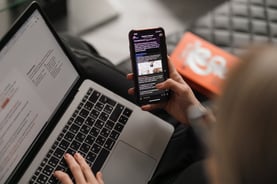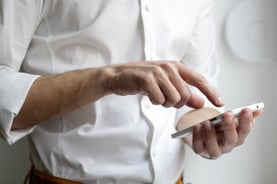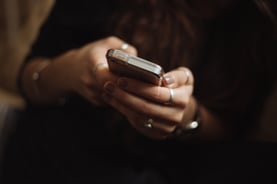 I scoffed when I heard that the average American spends four hours a day on their phones. Four hours? That’s literally two months of the year of mindless scrolling.
I scoffed when I heard that the average American spends four hours a day on their phones. Four hours? That’s literally two months of the year of mindless scrolling.
And then I checked my Screen Time.
Four hours and seventeen minutes a day on average.
That’s right. I’m worse than the average American.
Unappealing.
Not where I want to be.
I’m an absolute monster.
I know that I scroll through Instagram or get lost in a TikTok wormhole when I’m feeling at all bored or desperate to escape the Groundhog Day repetition of being a stay-at-home parent. I also am fully committed to changing my bad screen time habits and breaking my Smartphone addiction.
If there’s anything I refuse to be, it’s the average American. And if there’s anything I hope for, it’s to savor the precious time I have with my family instead of scrolling my life away.
Organizing My Devices
 The first step in getting a handle on my tech addiction is to clean up my act. I am notoriously technophobic and technosloppy. I have over 92,000 unread emails. I have no system for keeping my desktop and email ecosystem tidy, and I blame some of my bad habits on this disorganization. I check email incessantly throughout the day partially because there are thousands of emails that haven’t been properly dealt with.
The first step in getting a handle on my tech addiction is to clean up my act. I am notoriously technophobic and technosloppy. I have over 92,000 unread emails. I have no system for keeping my desktop and email ecosystem tidy, and I blame some of my bad habits on this disorganization. I check email incessantly throughout the day partially because there are thousands of emails that haven’t been properly dealt with.
I decide to bravely Marie Kondo my devices.
I’m due for a new computer, so I take this as an opportunity to force myself to come up with a logical system to keep things orderly. I tell myself that I cannot start using my new computer until I create folders for my email and GoogleDrive, get my email inbox to zero, and delete all unnecessary files off my desktop. I’m not about to go from one hot mess digital situation to another. The hot mess stops here.
I start by cleaning my desktop. This allows me to create folders that make sense for me. I delete every download and file anything I want to keep in folders. Then I transfer all those files to my GoogleDrive, where I promise myself I will be working from now on. This way, I can continue to delete files as needed and keep my desktop clutter free.
Then I use the same folders to start cleaning up five years worth of emails. I delete most of them and file the rest in folders. It takes three days and near constant work, but I’m finally able to get my email inbox to zero for the first time in my life.
I feel like a new man.
I also find that I’m checking my email a lot less throughout the day because I do not have any emails and relatively new ones appear.
I also unsubscribe myself to each unwanted piece of spam. This means that I’ll receive fewer and fewer new emails as time goes on, which feels like I’ve somehow gamed the system.
I’m checking my email a lot less, but that hasn’t stopped me from scrolling through Instagram and TikTok. I decide to take more decisive action toward ending my Smartphone addiction.
Turning Off Notifications
 My next step is to change all my phone notification settings. Like ALL of them. I turn off all notifications. All apps, texting, email, even phone calls.
My next step is to change all my phone notification settings. Like ALL of them. I turn off all notifications. All apps, texting, email, even phone calls.
Not getting pinged every time a friend has brunch makes me feel a lot less attached to my phone. I notice myself reaching for it less and less. I’m giddy at the thought that I’ve conquered my Smartphone addiction.
But then I look down to see my husband calling me. I answer, and he asks why I haven’t responded to his text. I know that it’s because I no longer check my texts. That’s when I realize that turning off all notifications has rendered my phone useless.
I need my phone for emergencies and certainly to stay in touch with my husband. It reminds me of why it’s so hard for me to lose the ten pounds I’ve been trying to lose for six months. I need food to live. I can’t just quit cold turkey.
I turn on my text and phone notifications and search for other solutions to prevent me from scrolling my life away.
Phone Jail
I’ve had my eye on those kitchen lockboxes for a whole year now. You can put whatever you want in there--cookies, booze, Smartphones--and then you set a timer and it locks your lusty item away until the timer runs out.
I order my lockbox and decide this is exactly the kind of solution I’ve been looking for.
I’m instantly enamored. I try locking my phone away for a minute.
Easy peasy.
Then I try five minutes. Then an hour.
Eventually, I’m locking my phone away for hours at a time and keeping it in there throughout the night. My lockbox addiction starts to replace my Smartphone addiction.
Unfortunately, locking my phone up has the same downside as turning off all my notifications. Sometimes I get a phone call or text that needs to be addressed promptly.
I stop using the lockbox and see that my screen time has gone from four hours a day to three.
I’m still wasting a month and a half of each year on my phone. That’s three years of my adult life.
I feel like a loser for not being able to put my phone down and keep it there. I’m still picking my phone up over 50 times a day, which seems excessive. I wonder if I’m picking up my baby 50 times a day.
This makes me feel depressed, so I pick my phone up to cheer myself up.
Then, ironically, my phone tells me how to solve my Smartphone addiction.
A Little Help From Opal
I start seeing Instagram ads for an app called Opal. Opal is this cute little blob who controls all the apps on your phone. You can tell Opal to lock you out of all your apps while you sleep or have dinner with your family or finish an assignment. I schedule some regular app shut off times for family dinner, getting ready in the morning, and sleeping. I also start telling Opal to shut down my apps whenever I want to be away from my phone--when I’m playing with the kids or reading a book.
Opal is the real game changer for me. It starts to be a game where I try to let Opal shut my apps off longer and longer each day.
Opal helps me get down to two hours of screen time a day. So I up the ante and tell Opal to start shutting my apps down 22 hours a day. I only allow myself between 8-9am and 8-9pm to have access to social media.
And this changes everything.
I’m now down to around an hour a day on my phone, and I pick it up around 30 times a day. That’s a drastic improvement.
My goal now is to stay below one hour each day. That’s only 15 days per year, which still feels unsettling. But hey, it’s good enough for now. It’s progress.
Decluttering my desktop and email and turning off my notifications were important steps for me to start confronting my Smartphone addiction, but I have to admit that it was the Opal app that has allowed me to significantly reduce my screen time. The thing I love most about it is that I can still receive texts and calls. It’s better than turning off notifications because I can’t even check my apps when Opal is doing its thing.
Everything In Moderation
 I’m not a total luddite. I appreciate how my magical phone can help me navigate and how it can help my children stay connected to their relatives that live so far from us. But I’m not about to let it detract from my time with my family and friends. I also don’t like the feeling of being controlled by my phone.
I’m not a total luddite. I appreciate how my magical phone can help me navigate and how it can help my children stay connected to their relatives that live so far from us. But I’m not about to let it detract from my time with my family and friends. I also don’t like the feeling of being controlled by my phone.
Screen time has been on the rise for years. We’re spending more time in front of screens than we are sleeping. If left unchecked, this rampant tech time gets in the way of our relationships and chips away at our mental health.
Everything in moderation.
So I challenge you to check how much time you spend on your phone and how many times you pick it up each day. Then ask yourself if that’s acceptable.
If it’s not, take some steps to work your way toward digital moderation.
There are still books to read and parks to visit. There are friends to get lost in conversation with and family members to connect with. There’s still time to be bored and to day dream.
Sometimes, we’ve got to put our phones down to truly experience life, to get lost in it and see where it takes us.
